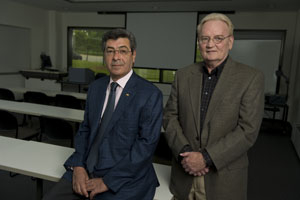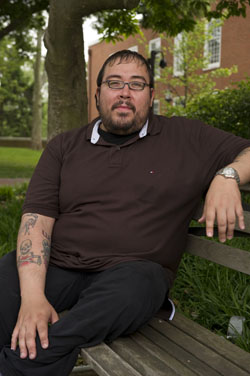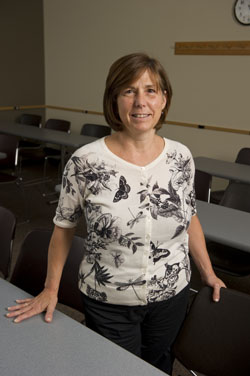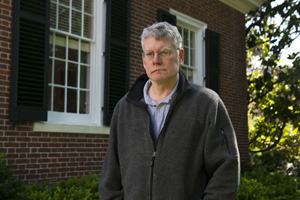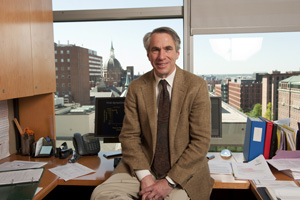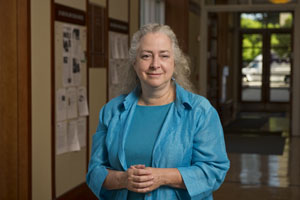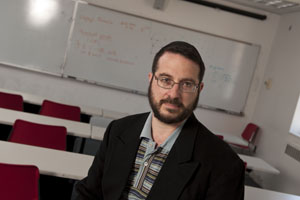May 24, 2010
Best in class
Recognizing Johns Hopkins University's top teachers
Some teachers are practical. They pepper students with real-world examples to illustrate course content. Some like to inject a little fun. To spice up a potentially boring lecture, one Johns Hopkins public health professor will have his students devise a financial analysis—for an ugly-baby clinic. Some openly show passion for the subject. Picture a music history professor nearly brought to tears reading excerpts from a composer’s diary.
Faculty employ a variety of styles to impart knowledge and get students to think critically, and each year some are recognized for their outstanding teaching ability.
Since 1992, the Johns Hopkins Alumni Association has annually recognized with its Excellence in Teaching Award university faculty who excel in the art of instruction. The award allows each academic division of the university to publicly recognize the critical importance of teaching. The nomination and selection processes differ by school, but students must be involved in the selection. Some schools give multiple awards in different classifications, such as the School of Public Health, which calls its awards Golden Apples.
This year, The Gazette wanted to hear from the faculty. What do they think makes them an effective teacher? What do they learn from their students? What is a favorite in-class moment? We also wanted to know who inspired them, their own favorite teacher. Some recalled their childhood, such as a School of Medicine professor’s parents who helped construct a chemistry lab in the attic.
What follows are the winners of the 2010 Alumni Association Excellence in Teaching Awards, sharing their perspectives in their own words. Not included here is the winner from SAIS, which gives its Excellence in Teaching Award to a faculty member at the Bologna Center and announces it at the center’s commencement, which will be held this year on May 28.
The interviews were conducted by Lisa De Nike (Arts and Sciences); Andrew Blumberg (Business); James Campbell (Education); Phil Sneiderman (Engineering); David March (Medicine); Jon Eichberger (Nursing); Richard Selden (Peabody); and Jackie Frank, Christine Grillo and Natalie Wood-Wright (Public Health).
—Greg Rienzi
BLOOMBERG SCHOOL OF PUBLIC HEALTH
Karen Bandeen-Roche, the Frank Hurley and Catharine Dorrier
Professor and Chair in Biostatistics
Course being recognized (large class size): Statistical Methods in Public Health

BLOOMBERG SCHOOL OF PUBLIC HEALTH: Alvaro Muñoz, William J. Ward, Elizabeth Stuart, Brian Schwartz and Karen Bandeen-Roche. Photo: Will Kirk/Homewoodphoto.jhu.edu
While I don’t consider myself a particularly effective teacher, I have a few thoughts about what may have worked this year. First, I believe students can tell when a teacher cares that they succeed, and I did care. Second, for subjects such as biostatistics in which concepts build, it’s important to present concepts systematically and in the right order, and I worked hard at that this year. And third, the class I was privileged to have brought incredible energy, curiosity and welcome into the lecture hall. They made a 150-person lecture feel like a group of 10 in my office with my couch and white board. What made me an effective teacher? They did.
My students have taught me everything I know about what it’s like to hear biostatistics for the first time. Each class has made constructive comments on building from the ground up, avoiding jargon and unintentionally condescending phrases—e.g., “The answer then follows straightforwardly…”—and using effective examples.
My own teaching hero is Mr. Hatt, my 11th- and 12th-grade math teacher. He was quiet, systematic, not an entertainer—a bit like me in these respects. He was so very clear, knowledgeable, authoritative, kind and fair that his students adored him, and I aspire to be like him in these ways.
One of my best experiences at Hopkins was a day in the 1993–94 school year when my class surprised me by getting an overhead projector—we still used chalk and board back then—and taking over the front of the classroom. They’d made up—and performed—a series of biostatistics songs lampooning and praising biostatistics itself and the course in particular. There was so much fun and spontaneity, and affection, in it.
Alvaro Muñoz, professor of epidemiology
Course being recognized (small class size): Advanced Methods for the Design and
Analysis of Cohort Studies
I try to bring our research findings into the classroom. When I’m teaching a course, my guiding principle is the re-enactment of all the steps toward reaching a scientific publication.
My students have taught me a lot because the evaluation of the course is based on the writing of the “Methods” and the “Results” sections of a manuscript. After the second week of the course, half of the classroom time is dedicated to students presenting their progress toward the paper. These papers can be based on data we prepared for them from our studies, or they can be based on class data from the students’ own projects. The course is different every year.
In third grade, I was selected by my math teacher to be photographed for the cover of the school’s yearbook. In the background of the photo was a blackboard on which was written the following equations: _ X 2=14, _ X 8=56, and _ X 9=? Not only did it require me to provide the answer (63) to the last question, but it also required the imputation of the “7” in all the blanks. Imputation today is a key component of what we do with missing data.
In college, my professor of logic, J.C. Ochoa, made fun of me for doubting the validity of the induction principle—that was my most memorable classroom day.
Elizabeth Stuart, assistant professor of mental health, biostatistics
Course being recognized (small class size): Causal Inference in Medicine and Public Health
I draw much of my inspiration as a teacher from David Cohen, my adviser and mentor in college, and a master teacher. He was a firm believer in the maxim “You don’t know it if you can’t teach it to someone else.” He practiced that idea in his classes through presentations, group work and pyramid exams that had individual, group and classwide components. It was through David that I learned how to communicate mathematical concepts to people who may not have a lot of background in mathematics, and how to connect those concepts to the real world. His warmth, love of teaching and advising, enthusiasm for mathematics and level of caring for his students inspire me to this day.
Bridging the gap between the classroom and the real world is so important for students. It was a seventh-grade project that helped to crystallize that connection for me. My biology teacher set up a fake food-poisoning outbreak in our small town. Our assignment to track down the source of the disease involved interviewing people around town who had been told by our teacher what to say. It was one of the first times that I really saw how the sciences could be used in the real world to improve health.
I think my teaching and my relationships with my students are enhanced by the fact that I remember what it was like to be a student. I try to be as open, accessible and clear as possible. I also try to think about what sorts of practical skills and knowledge the students need and want, and tailor my teaching to that. Many of my students ask tough questions and have strong critical thinking skills. They help me to think about statistics and its applications in new ways. Teaching good students makes you a better teacher and a better researcher.
Brian Schwartz, professor of environmental health sciences
Course being recognized (medium class size): The Global Environment and Public Health
Teaching gives me great pleasure, and the work we enjoy is the work we care about and try to get better at. In addition, the topic of global environmental sustainability is incredibly important, timely and significant to public health now and in the future. It is about how we live, our impact on the planet, what this is likely to mean in the future, what it means to live in the context of sustainability and what we must do to get there. These are topics that students read and hear about outside the school every day, so there is significant and growing interest, and much opportunity for exploration and discussion. These are issues that I’m extremely passionate about, and it’s safe to say I wear that passion on my sleeve. I try to be provocative and challenging, on what for many are very controversial issues, which makes it fun for most but perhaps a bit uncomfortable for some, especially in a class that’s offered at 8:30 a.m.
Mrs. Priest, my second-grade teacher, changed my life. Up until that point—and a lot since then—I had been a cantankerous and unruly little elementary school student. She figured out that if she made me run to the top of the hill in the back of the school that I would come back ready to learn and behave a bit better. And getting to go outside so much was fun for a second-grader. It has been all downhill, pun intended, since that time.
Over the years, I’ve learned that students are moved, activated and motivated by passion. My most memorable moment in the classroom was in August of 2007, when I gave a new lecture on climate change, peak oil and the coming era of energy scarcity, ecosystem and species issues, connections to the built environment and the implications of all this for public health. It was completely unexpected, but after that lecture, a group of around 10 to 12 students and I discussed the topics in the Bloomberg School’s second-floor coffee shop. For an hour or so, we stood in a circle engaging and challenging each other. That group wanted more, and became the first “sustainability seminar” group. We met weekly for the rest of that year, with the group growing to around 25 students, ending just before graduation with a sustainable vegetarian dinner.
It was this interest and feedback from students that motivated Global Environment and Public Health co-director Cindy Parker and me to expand the teaching of the Program on Global Sustainability and Health, develop the MPH concentration on global environmental sustainability and health, and offer two standing seminars in the second and fourth terms on sustainability issues. This has become a convenient setting for students to begin to get their feet wet on these issues, or to immerse them more fully. Those original students who showed interest and passion in these issues back in 2007 were the impetus for much of what has come since, including this Golden Apple award.
William J. Ward, associate professor of public health and nursing
Course being recognized (Internet class): Fundamentals of Budgeting and Financial Management
I think I bring a practicality to the classroom that my students appreciate. That real-world component comes from my experience as a health care executive and consultant. As a former chief operating officer at what is now Johns Hopkins Bayview Medical Center, I’m able to draw on my past career to explain financial concepts in everyday terms that students can relate to.
I teach finance not from the bean counter perspective but from the operator perspective, focusing on the question, “I’ve got all these patients; now how do I deal with the money?” Recognizing that some topics can make for potentially boring lectures, I try to inject an element of entertainment whenever possible, sometimes using cartoons and video clips in my teaching. I’ve found that creating a fun scenario to address a course topic can spark some lively discussions. The lecture might be on putting together a financial analysis to support a new immunization program, but it’s a lot more fun to put it together for an ugly-baby clinic.
One particularly unusual technique that I used to enhance the energy level in class involved crime scene tape. The class was held in a cavernous lecture hall, and most of the 60 students would typically sit in the back rows. I like to wander around when I teach, so I spent a lot of time and energy running up and down the steps of the hall to connect with the class. After a couple of weeks of unsuccessfully asking the students to sit closer to the front, I broke out the yellow crime scene tape—please don’t ask me why I have this stuff—and cordoned off most of the room so they had to sit in the first five or six rows. It worked. The result was a much better classroom discussion and student engagement and a lot less wear and tear on my knees.
Finally, a big part of my effectiveness as a teacher stems from the energy that I draw from the students. When they’re enthusiastic about learning, I’m enthusiastic about teaching.
CAREY BUSINESS SCHOOL
Paul Duffy, practitioner faculty, Master of Science in Marketing
I’ve had decades of experience in performing actual marketing research and marketing consulting. I think that’s what the students in my classes most value.
What have I learned from my students? The challenge of trying to be as relevant as possible for their current needs for marketing knowledge is certainly one important thing. They are really quite creative and insightful, so staying current with my students and the challenges that they’re facing is always an issue. The caliber of students in our school today is as high as I’ve ever seen it, and it’s probably going to get even higher.
My favorite teacher was the adviser for my dissertation, Alfred Lit. First of all, he was a fine, gentle man. He was also an outstanding scientist. I won’t go into all the esoterics of his particular area of study for which he was internationally renowned, but he was instrumental in guiding me in two areas. The first was statistics. He demystified it for me. The other area dealt with how to do science, how to be a scientist and how to maintain some humility in the face of the uncertainty of our results.
Here’s an anecdote, and it’s similar to what my students go through. When you’re a bright, bushy-tailed graduate student and you’re learning all of this new stuff, it’s all very exciting to you. We were in Lit’s laboratory one day, and he was showing us all these pieces of equipment, sophisticated technology at least for the time. He was a psychophysicist and he was studying vision. We were saying “ooh” and “ahh.” We were just in awe of it all. Then suddenly he turned to us and said, “But do we know what it all means?” To which he provided the answer, no. His point in all that was that we can be as exact as humanly possible, but we really have to stop and think what all of this data and these observations really mean. What are we really doing in the world? That stayed with me for a long, long time. We do the best we can to come up with the best answers, but we still might be wrong. We have to allow some room for error, and contemplation.
Reza Djavanshir, associate professor, practice track
There are two factors that come into play to motivate me to do my best for my students. The first is the current dynamic in our new school. I am very inspired in doing “my share” in making the Carey Business School the newest arm of the great research university that is Johns Hopkins so that the Carey name will resonate throughout the world, as do Hopkins’ other schools. Second, my students love my past business and corporate experiences. I was fortunate to work for some very progressive firms and was tasked with both challenging and interesting assignments and projects. One example was at GTE Telenet, where we were working on early Internet technology and projects for the Department of Defense.
I find my students have a strong drive to be successful academically as well as professionally. My previous work experiences have enabled me to know how to succeed and excel in corporate environments, what those businesses are looking for and demanding from their technical and management staffs who have graduate degrees from a top university such as Johns Hopkins, and I try to communicate those qualities and values to my students on an ongoing basis.
I strive to create a participative and interactive environment. I assign my students plenty of reading, including case studies and research articles from the best professional business journals available. Then we discuss, translate, relate and directly link the academic subjects to real-world business problems and try to create solutions to those problems, realizing the highest caliber of innovative solutions businesses expect from their employees and our graduates. I’ve found that all this motivates students and fuels their intellectual curiosity to learn better, study harder and do more research to become successful and excel both academically and in the business environment.
I have fond memories of those professors who helped me earn my doctorate—Eisener, Singaporewall, Fiacco and McCormick. I’d feel guilty if I singled out one over the others, but I can truthfully say that they all motivated and inspired me to stay on the path to success, even if I didn’t feel so confident myself sometimes.
KRIEGER SCHOOL OF ARTS AND SCIENCES
Christian Villenas, graduate instructor in Sociology
One of the things that I think makes me an effective instructor is that I not only know my material, but I also work very hard to make sure that material is up-to-date and relevant to the students. Today’s students live in a world in which information and news are available in real time, which means it is not unusual for students to be logged onto the Internet during class and pulling up information as we go along. I am aware of that, so I try to be one step ahead of them. For example, in one of my disability classes, we talk about the right-to-die issue. There is always some case in the news involving this, so that would be something relevant and newsworthy that I could bring up for discussion. Students, I find, retain the information better when they can relate to something current.
It’s funny—I think I have done just as much learning as an instructor as I did as a student. One tends to think that, as a teacher, you would have it all figured out, but that’s not the case. Every so often, a student will bring up a perspective that is remarkable and challenges the rest of us, especially in classes regarding people with disabilities. Johns Hopkins has a very low number of people with disabilities, so teaching here is a window or lens onto how members of this generation, in the general public, view people with disabilities. I use crutches to get around, so I do sometimes worry that students who might otherwise be outspoken on certain topics might hold back, for fear of offending me. I hope they don’t do that. I always want an open and honest discussion.
I can’t say I personally had the best educational experiences growing up. In fact, I don’t think I understood what effective teaching was until graduate school. That’s probably because my physical disability meant I was placed in special education classes until middle school, when I was tested academically, and then I actually skipped a grade. Those early experiences have really shaped me to want to be a teacher who is tuned into the needs of his students and who notices each student’s particular abilities. I have found that I have been very inspired by the Sociology faculty here at Johns Hopkins. However, there’s no question that my earlier experiences as a kid in school have driven me to be extra committed to excellence in teaching.
I’ve had a number of memorable moments or experiences in the classroom, especially in my disability-related courses. In one course, the students end the semester by working in groups to analyze some aspect of campus based on access for disabled people. They have looked at everything from physical access to access to housing, athletic events, programming and even social-life issues. They then present their findings to the university community, and it is on that day that I am the most proud of my students.
Over the years, they’ve found that there are a lot of issues for disabled people on our campus and in our university community. For example, they discovered that a person who uses a wheelchair to get around would have to sit on the opposing team’s side of Homewood Field to watch a game. That’s awful. The bookstore, where readings and other events occur, is really difficult to navigate in a wheelchair, too, and getting from the lower to the upper quad is a nightmare. My students’ commitment to this project and to this issue has been extraordinary. Without them and their hard work, issues of disability access would not be as much in the view of the JHU administration as they are now. Even though we, as a community, have a long way to go in terms of making this campus completely physically, and socially, accessible to individuals with disabilities, it’s been wonderful to see the efforts my students have made toward social change.
Stefanie Deluca, associate professor of sociology
Editor’s note: Deluca was traveling and unavailable for this article.
PEABODY
Andrew Talle, chair of Musicology
Courses being recognized: Introduction to Western Music History (Krieger School), Bach at the Keyboard (Peabody doctoral colloquium)
The fact that I am very comfortable around performers is probably my most important asset as a faculty member at Peabody. I spent my childhood and college years planning to become a professional cellist, so I have a lot in common with conservatory students. We attended the same music schools and festivals, and in some cases even studied with the same teachers.
I have benefited a lot from discussions with students, especially outside of class, where there is less time pressure. Explaining concepts and ideas to students with good critical minds forces me to re-evaluate the assumptions behind them. When I read my own evaluation forms, I tend to agree more with the students who make negative comments than with those who make positive comments, though of course the praise makes me feel better.
I am grateful to many, many teachers. I can only reduce the number of favorites to three: Hans Jørgen Jensen, my cello teacher at Northwestern; Thomas Kelly, a scholar of medieval music and gifted administrator at Harvard; and Ngô Nhu Bình, my Vietnamese language instructor at Harvard. Ngô Nhu Bình follows a doctrine described in Vietnamese by the expression “Gio cao dánh khe,” which means “Raise the stick high but hit gently,” which I have tried to emulate.
Certainly my most memorable day in the classroom took place at Peabody in March of 2005, in the middle of a graduate seminar I taught on Robert Schumann. The night before the particular class period in which I was to discuss his last months, I was up late translating Clara Schumann’s diaries. After 20 years of marriage, Robert began to have psychotic visions, tried to commit suicide and eventually had to be housed in an asylum, where Clara visited him regularly. Maybe it was just because I was so tired, but during the lecture I could barely pull myself together. I couldn’t even look at the class while I was reading the diary excerpts for fear that I would start crying uncontrollably. At the end, in some desperation, I just put on a recording of Schumann’s Requiem and the students filed out in silence. I had never taught a class like that before, and have never since.
SCHOOL OF EDUCATION
Mary Hendricks, adjunct faculty in early education
Course being recognized: Early Childhood: Instructional Program Planning and Methods
As a child, I remember visiting my aunt and uncle and being impressed by how they cared for my cousin. Although severely disabled, she was surrounded with love and participated in all family activities. However, the local public school was not open to her because of her disability. I thought this was very unfair, and it led me, as a teenager, to decide on a career in special education. I eventually earned a master’s degree at Johns Hopkins and have spent the past 32 years in the profession.
I credit my parents for getting me started on this career path. They encouraged me to follow my passion. My mother helped me to set goals, and my father taught me that whatever I do in life to work hard and do it well. In 2003, I became an adjunct faculty member in the School of Education. This has been an exciting experience for me as I can share my passion and experience as a practitioner to help a new generation of special educators. I know that many policy-makers never make it into the classroom, and here at Johns Hopkins I have the opportunity to discuss policy and how that translates into real-life application.
My teaching experience has helped me grow as a professional. I have learned the importance of being flexible. Sometimes I’ll go into a class thinking I’m totally prepared, and there will be a question that will take the class in a completely different direction. My students challenge me to stay ahead of them and to keep current with the literature.
My most memorable classroom moment came when I asked for technical help for a PowerPoint presentation. The computer wasn’t working properly, and this was the last class before finals. A tech person made the repair and as he was leaving, I asked what caused the problem. I couldn’t hear his answer and asked him to repeat it. Trying not to embarrass me, he said the computer needed to be plugged in.
Stephen Vicchio, adjunct faculty, Public Safety Leadership
Course being recognized: Ethics and Society
I didn’t know what to expect when [then] Dean Stanley Gabor invited me to have lunch with him at the Hopkins Club 15 years ago. He asked if I would be interested in teaching an ethics course in a new program for police, fire and safety personnel. Intrigued by the offer, I happily accepted. The program is now part of the School of Education’s Division of Public Safety Leadership.
My classes, which are made up of public safety personnel from across the state, are different from other college classes that I have taught because of the depth of the knowledge of the students, the range of their experiences, and they never run out of moral dilemmas to discuss. It has been as much of a learning experience for me as, I hope, my students. Some of the examples that come up in class are quite compelling and lead to provocative discussions, such as the situation experienced by a young police officer while on duty in western Maryland. The officer, whose grandfather was killed by members of the Ku Klux Klan, was ordered to provide security at a rally for the group. Initially, the officer put his badge and gun down and refused the assignment. After agonizing over the decision and discussing it with his supervisors, he took back the badge and gun and completed the assignment.
My most memorable class involved a discussion about individuals acting in a morally responsible way. The class was working with the premise that it is morally right if you think, feel or believe it’s right. After much discussion about who is morally right, one student said, “I have a gun, so I must be right.”
I first met my favorite teacher, Kingsley Price, when I was in undergraduate school and responded to an ad to be a reader for a blind professor. This professor of philosophy at Johns Hopkins was an amazing man. I would spend hours reading books and articles to him, and he would recall specific quotes on specific pages. We became great friends, and our relationship lasted 40 years. Kingsley died last year at age 91. He was one of the most patient and thorough persons I have ever known, never angry and always on point. He taught me many life lessons.
SCHOOL OF MEDICINE
Robert Siliciano, professor of medicine and Howard Hughes Medical Institute investigator
Course recognized: Principles of Immunology
I think a love of teaching must run in my family. Coincidentally or not, my younger brother, Paul, a biochemistry professor at the University of Minnesota, also received a university teaching award. I think we both owe a lot to our late mother, Ann, who was a dedicated anatomy and physiology professor at Elmira College in upstate New York, where we were raised.
We used to always have as a guest at the kitchen table a nursing student whom our mother would be tutoring. She instilled in both of us from a very early age a love for the material and the need to find a clear way to express complex concepts.
I am always impressed by my students’ curiosity and brilliance. You see how smart these students are, and you think that there is no problem in this world that is too big to be solved, even AIDS.
My two favorite teachers would have to be my parents, who supported my early beginnings as a research scientist. My mother and father, an orthopedic surgeon, gave me their full support in constructing my first chemistry lab in the family attic. [My mother] would supply industrial-grade chemicals, including ether, benzene and concentrated hydrochloric acid. I even had my own Bunsen burner, glass beakers and flasks. I used an electric fan to blow the fumes out a window, with only a few minor mishaps.
SCHOOL OF NURSING
Sarah “Jodi” Shaefer, assistant professor, Nursing Systems and Outcomes
Recognized for: Excellence in undergraduate teaching
Originally, I came from a public health and clinical specialization background and then transitioned into academia. It’s been a challenging transition, and one thing I’ve learned is to be clear with my students regarding my expectations. I try to make it clear that my role is to help them learn the content. They’re responsible for the preparation, but I help them achieve the objectives.
The thing I have learned from our students is that they bring amazing skills, capabilities and work experiences to the field of nursing. I have watched the students take this strength and apply it to a health education class for students at Dunbar Middle School. They have taught me new ways to engage middle school students. I’ve also learned how to harness the students’ skills and enthusiasm. Two Accelerated 2010 students share my passion for family support following infant death; together we are writing an article about bereavement needs for a Hindu or Buddhist family following an infant death.
My favorite teacher was Mary V. Neal at the University of Maryland School of Nursing. She was a good match for my learning style because she gave general directions and expected me to figure out the solution or answer or to ask questions. Neal was a leader in nursing and showed me the possibilities for a nursing career.
If I had to pick my most memorable day in the classroom, it would have been this spring, when I returned to class after my husband passed away. It was an Accelerated 2010 research class, and upon returning, I thanked them for their kindness in this very difficult time. I had sent them information about my husband’s unexpected death and told the class how to help when faced with a patient/family unexpected death. Through my experience, I was able to teach my students for their future practice. It was a teachable moment that had nothing to do with nursing research but how to be “human” and kind to families faced with tragedy.
Mary Terhaar, assistant professor, Nursing Systems and Outcomes
Recognized for: Excellence in graduate teaching
I love being a nurse. I find it to be a very satisfying career. Every day, there’s a different challenge, and as a teacher, you can make a difference. I want my students to fall in love with what they do, and carry that passion with them into their careers.
What I’ve learned from my students, particularly my doctor of nursing practice students, is that you have to take risks. Our DNP students are experts in what they do—they’re directors, managers, nurse practitioners—but they’ve taken a risk by coming back to school. They want to learn how to be the best at what they do. There’s an inspirational poster that reads, “What if the very best thing in your career hasn’t happened yet?” That’s what I’ve learned from the students. It’s a reality check to see if I’m doing the best I can.
If I had to pick my favorite teacher, it would the dean at the Catholic University of America, Sister Rosemary Donley. She gave us a different perspective about the knowledge we bring to a particular problem. It is important, she said, to integrate the arts, sciences, nature and other fields to help impact our thinking; by doing so, it will have a greater impact on our work, and make our work more satisfying and rich.
My most memorable classroom experience involved a group of clinical students that included a vice president of information technology from Silicon Valley, the owner of the largest chain of yoga schools on the East Coast and a prosecutor. Part of their clinical [experience] involved witnessing the birthing process, and it was amazing to see how each of these three students reacted. Naturally, all three were placed outside their comfort zones, and by the end of the day, each was a totally different person. It was amazing to see the transformation.
WHITING SCHOOL OF ENGINEERING
Donniell Fishkind, associate research professor
In 1998, I graduated with a doctorate from the Department of Applied Mathematics and Statistics in the Whiting School. After two years in a tenure-track position at the University of Southern Maine, I was invited to visit my old department at Johns Hopkins for a year, and I took a leave of absence to do so. One year became two years, and the visit became a residence. Since my re-arrival in 2000, my position transitioned to associate research professor. My experience at Johns Hopkins as a student is a valuable asset for teaching here. I know the culture and challenges from both sides of the lectern. I also recognize that my students are the pool of talent from which I came. When I was a student, many of my peers had abilities surpassing mine in different ways. Many of the students whom I teach today have strengths and will achieve accomplishments that will far eclipse mine. It is an honor to contribute to their development.
The biggest influence on my teaching has been Professor Edward Scheinerman, who is now vice dean of education in the Whiting School. He taught graph theory when I was a student here. His enthusiasm for the subject material and the clarity of his exposition made him my model to emulate as a lecturer.
Regarding my own teaching career, several memorable experiences come to mind. At the University of Southern Maine, a student phoned me before an exam to tell me that he wouldn’t be able to sit for the exam, and he promised me evidence of extenuating circumstances. A few days later he came by my office with a bandaged face and a video. It seems that my mild-mannered student of statistics had an additional vocation as a semiprofessional wrestler. The video featured a professional-looking wrestling match—replete with enthusiastic audience—in which my student was flipped head over heels out of the ring to crash face-first through a table. Certainly it was one of the more unusual forms of illness documentation that I have seen.
On a more serious note, my best moments as a teacher have occurred when struggling students break through a general barrier in understanding, sometimes very far along into the semester, and gain mastery of the course material. A sense of achievement is visible on their face when they confidently hand in their final exam. Indeed, the victories that are hard-fought are the most satisfying, and it is a real pleasure to play a role in them.



